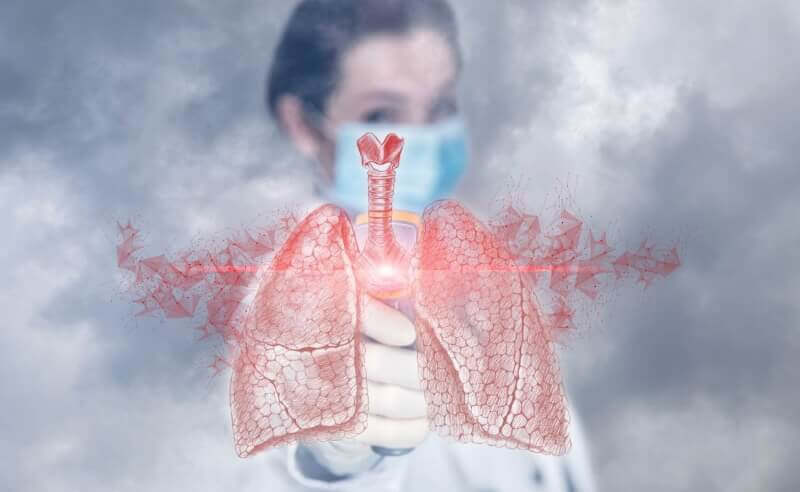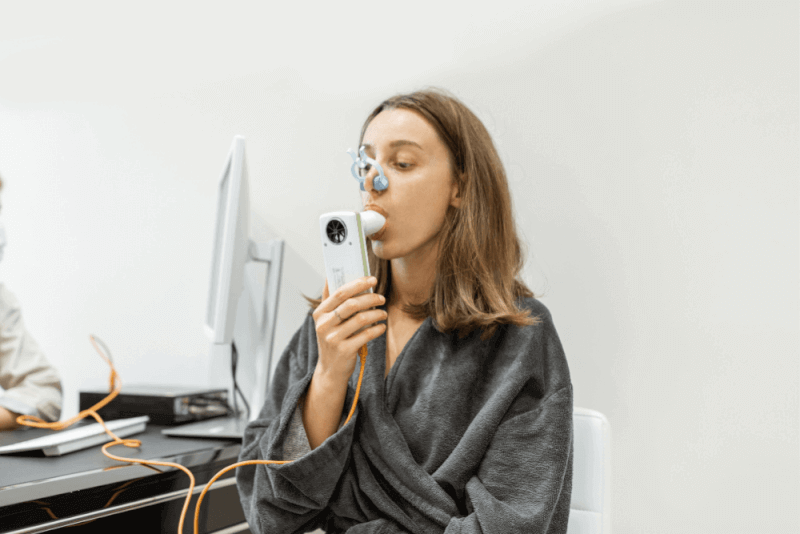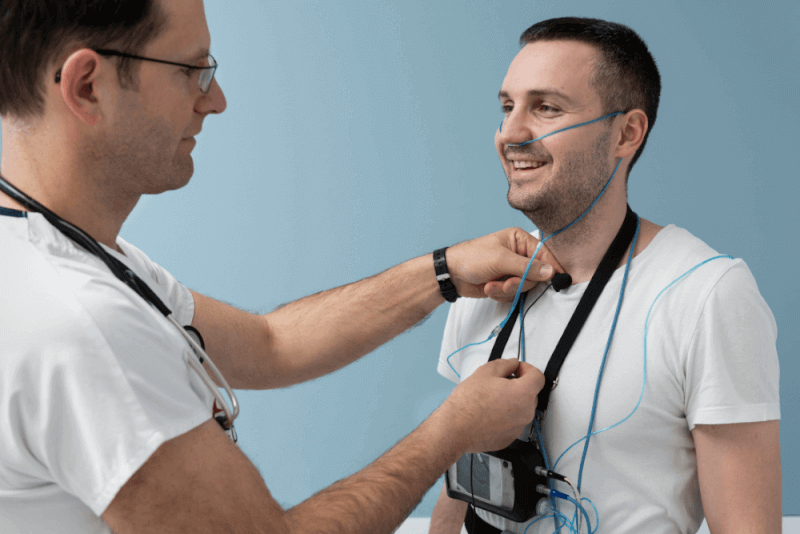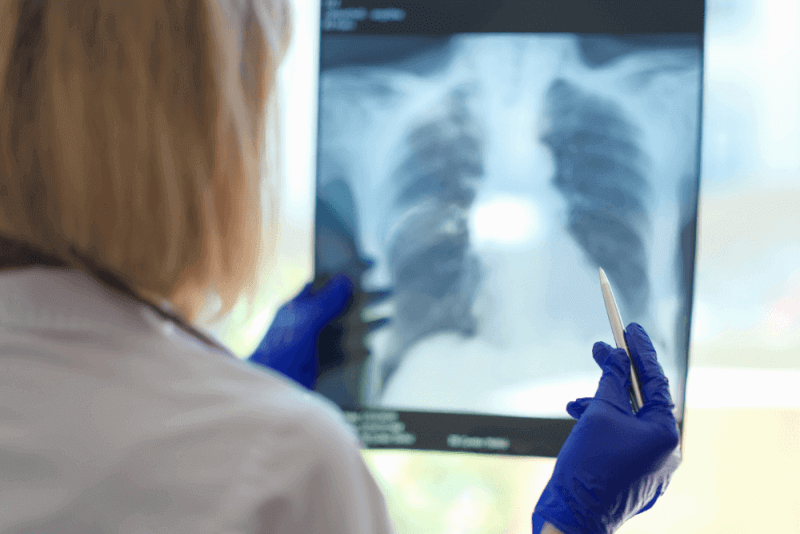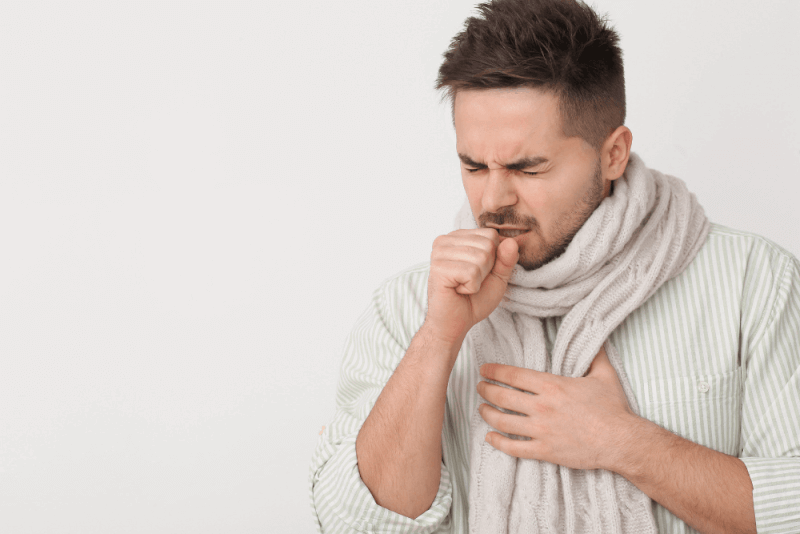30 Second Summary
- The most common symptoms of COPD are shortness of breath, cough and phlegm.
- COPD is a lung disease characterized by narrowing of the lungs and inflammation of the airways.
- The most common cause of COPD is smoking, but other factors such as air pollution, dust and chemicals can also increase the risk.
- People with COPD can improve their quality of life by leading a healthy lifestyle, exercising regularly and quitting smoking.
What is COPD?
COPD, a term created by combining the initials of chronic obstructive pulmonary disease, causes blockage of air sacs in the lungs. These air sacs in the lungs are called bronchi and are filled with oxygen with breathing. This oxygen is then transported to other tissues of the body through the blood vessels. In COPD patients, there is a serious decrease in the amount of oxygen stored in the lungs because the bronchi cannot work at full capacity. Therefore, it is not possible to deliver enough oxygen to the tissues.
COPD is diagnosed in patients who smoke and have long-term complaints of shortness of breath, cough and phlegm. However, patients must undergo a respiratory assessment test to confirm this diagnosis. It is also recommended that people over the age of 40 and smokers should have a respiratory assessment test once a year.
Diagnostic criteria for COPD
Smoking is an important criterion for the diagnosis of COPD. The patient's complaints are also taken into consideration. In order to make a definitive diagnosis of COPD, patients are asked to undergo a number of tests. These tests include the following:
- Lung X-ray
- Blood count
- Biochemistry
- Arterial blood gas determination
- Respiratory test tomography
Respiratory assessment test
The respiratory assessment test is one of the most important tests for the diagnosis of COPD. This test is extremely important not only for diagnosing COPD but also for determining the stage of the disease and lung capacity. finally, the respiratory assessment test differentiates COPD from other lung diseases. and also used for
Causes of COPD
The biggest cause of COPD is smoking and the use of tobacco products. People who are constantly exposed to cigarette and tobacco smoke are also more likely to develop COPD. The research on the causes of COPD conducted by the World Health Organization also found that the following factors also cause COPD:
- Polluted weather conditions
- Workplace exposure to dust, chemicals and smoke
- Organic fuels such as dung and wood used in domestic environments
- Genetic diseases
- Becoming a man
- Age
- Previously diagnosed with asthma
- Experiencing a serious respiratory infection in childhood
- Problems with lung development
- Socioeconomic level
- Chronic bronchitis
- Harmful gas exposure
Symptoms of COPD
The main cause of the symptoms of COPD is the greatly reduced capacity of the bronchi. For this reason, adequate oxygen delivery to the tissues is not ensured and various symptoms appear in patients. These symptoms include the following:
- Shortness of breath, especially during physical activities
- Swelling of the ankles, feet or legs
- Wheezing
- Unwanted weight loss
- Shortness of breath
- Depression
- Tightness in the chest
- Fatigue
- White, yellow or green colored sputum
- Fatigue
- Cyanosis
- Frequent respiratory infections
COPD treatment methods
In the treatment of COPD, there is no method to cure the disease. Instead, symptomatic treatment is used to reduce the complaints of patients. Because the damage to the lungs cannot be reversed. The first and most important step in the treatment of COPD is for the patient to quit smoking if they smoke.
COPD treatment varies according to the stage of the disease. However, the most important part of treatment is to prevent periods of exacerbation or, if exacerbation cannot be prevented, to treat complications during this period.
Antibiotic treatment
Infection is the most common problem during exacerbation of COPD. This infection, which usually occurs in the lungs, causes the patient's clinical picture to deteriorate rapidly. Since the deterioration of the lungs of COPD patients increases the risk of infection, the infection should be treated as soon as possible with rapid medical intervention.
In case of infection in the lungs of COPD patients, they are given medicines for infection in addition to the medicines they use regularly. Doctors also recommend various vaccinations to prevent possible infections.
Pulmonary rehabilitation therapy
Especially patients with moderate to severe COPD prefer not to leave the house because they experience severe shortness of breath during physical activity. This leads to weakened muscles and reduced mobility. Pulmonary rehabilitation therapy is recommended to strengthen the muscles of patients in this condition. This treatment method not only helps patients to maintain their muscle strength, but also ensures that their breathing is regular. With simple movements, a significant increase is seen in the quality of life of patients.
Oxygen therapy
In severe cases of COPD, there is a significant drop in oxygen levels in the blood. For this reason, oxygen therapy is applied to these patients. Oxygen therapy should be applied for at least 15 hours a day. In this way, patients experience a significant reduction in complaints of shortness of breath and a significant increase in their quality of life.
Medication
Other treatment options that can be applied to COPD patients include the following:
- Expectorant drugs
- Breathing medicines
- Cough suppressants
- Respiratory rehabilitation
- Physical therapy
- Pneumonia and flu vaccinations
- Respiratory support devices
In the medical treatment of COPD, some medicines are taken orally, while others must be inhaled. Taking inhaled drugs with the right techniques increases the success rate of the treatment.
COPD balloon therapy
Balloon therapy, which is one of the supportive therapies whose use in COPD treatment is increasing day by day, is especially applied to COPD patients with chronic bronchitis.
In balloon therapy, bronchoscopy is used to access the airways in the lungs. The thickened airway tissue is then excavated and removed using a vibrating balloon. This procedure restores the airway as close as possible to its healthy state. In this way, patients' breathing is relaxed and their physical activity is increased.
Stages of COPD
The staging of COPD depends on the severity of shortness of breath in patients.
1st mild stage
Diagnosis can be challenging for patients in the mild stage. During this period, when symptoms are extremely mild, they can be confused with other lung diseases.
1.mild stage symptoms
Symptoms in the mild COPD stage are shortness of breath after high exertion, such as heavy work, climbing stairs or walking fast. Because the symptoms are limited to this, diagnosis is difficult.
2nd middle stage
Symptoms in patients with moderate COPD are more severe than those in mild COPD. This makes it easier for patients to receive a diagnosis. Symptoms in the middle stage begin to affect patients' daily lives.
2.middle stage symptoms
Symptoms seen in the middle stage include the following.
- Experiencing shortness of breath during physical activities that require conditioning
- Increased severity of phlegm and cough
- Illnesses such as lung infections or colds take longer to recover than usual
3rd severe stage
If COPD progresses to a severe stage, patients' daily lives are severely affected. In addition, patients' general health deteriorates as their sleep starts to be affected.
3.severe stage symptoms
Symptoms that can be seen in patients with severe stage COPD include the following.
- Shortness of breath during daily activities
- Fatigue
- Sleep disorders
- Shortness of breath starts to appear at night
4.very severe stage
The shortness of breath experienced by very severe COPD patients becomes permanent. Therefore, patients are unable to leave the house or even walk comfortably in the house. In the last, very severe stage of the disease, patients need bed care.
4.very severe stage symptoms
Symptoms seen in very severe COPD patients include the following:
- Edema in the legs
- Neck veins become prominent
- Trembling in the hands
- Numbness in the hands
- Sexual aversion
- Constipation
- Abdominal swelling
- Slimming
- Asabiyet
- Forgetfulness
- Insomnia
- Bruising of the lips, fingertips and tongue
- Sweating
- Severe headache
- Palpitations
Types of COPD
COPD is divided into various types depending on its cause.
Chronic bronchitis
Chronic bronchitis, which often precedes COPD, can be considered the first stage of COPD for smokers. It is therefore extremely important to treat it. Acute bronchitis is a disease caused by recurrent respiratory infections. Due to its constant recurrence, it causes damage to the bronchi, which significantly increases the likelihood of COPD in patients.
Emphysema
Emphysema, which is seen due to reasons such as long-term smoking and exposure to polluted air, is rarely seen due to genetic inheritance. Damage to the alveoli and other respiratory tissues due to various causes is called emphysema. Emphysema, which can be easily controlled in its early stages, is a disease that requires inpatient treatment in its later stages.
Bronchiectasis
It is the enlargement of the bronchi, usually due to infections or inflammatory health problems. This enlargement is caused by permanent damage to the elastic structures and muscles in the walls of the medium-sized bronchi. Thanks to antibiotic treatments, it is in decline, especially in developed countries.
Bronchial
Basically, it is a disease caused by a reversible narrowing of the airways. The narrowing of the airways is caused by triggers. Bronchial is divided into allergic and non-allergic. Allergic bronchial type is especially common in children with a family history of allergies. Allergic bronchial allergy is often triggered by allergens but can also be caused by occupational exposure.
Bronchial attacks can occur suddenly or last throughout the day and are less severe. The shortness of breath experienced by patients is recurrent. can only be completely cured with medication.
Nutrition in COPD patients
Nutrition is of great importance in controlling shortness of breath in COPD patients. For this reason, there are some points that COPD patients should pay attention to in their diet.
What COPD patients should avoid in their diet
Floury, sugary and starchy foods are among the foods that COPD patients should exclude from their diet. In addition, foods that patients should avoid include the following.
- Refined sugar should be avoided.
- Foods that may cause digestive problems should be avoided.
- Large portions should be avoided at meals.
- Foods that cause gas should be avoided.
- Salt consumption should be limited. Because excess salt consumption causes edema formation in the body and therefore difficulty in breathing.
Foods that COPD patients should add to their diet
It is recommended that COPD patients maintain a healthy weight to reduce shortness of breath. For this, a healthy nutrition program should be established and if they are not at a healthy weight, they should go down to their ideal weight.
- A protein-rich diet is recommended for people with COPD.
- They should get about half of their daily energy from quality fats.
- Foods rich in fiber should be preferred.
- Fresh fruit and vegetable consumption should be increased.
- Particular attention should be paid to potassium consumption. Because potassium deficiency causes shortness of breath even in people without lung problems.
How many years do people with COPD live?
COPD is a chronic disease that progresses slowly. They therefore have a long life expectancy. However, patients with end-stage COPD have a life expectancy of approximately 5 years. However, this period varies depending on the general health status of the patients and the patient's system.
Symptoms of COPD death
Symptoms seen in patients at the end of the very severe COPD stage, which is the last stage of COPD, include the following.
- The patient starts to have problems with depression during his/her lifetime
- Severe pressure and pain is felt in the chest area.
- Dizziness starts to occur.
- Problems falling asleep
- The patient feels constantly weak and tired
- Problems starting to occur in eating
- Difficulty breathing even when not moving
- Rapid weight loss
- Irregular heartbeat
- Continuous wheezing during breathing
- Chronicization of cough
- Increased sputum production
- Hearing crackling in the voice when breathing in and out
What are COPD attacks? How does it work?
COPD attacks are also called COPD exacerbations. There is an aggravation of the complaints seen in patients during COPD attacks. Cough, phlegm and shortness of breath are therefore exacerbated during attacks.
COPD attacks follow a different course in all patients. Attacks are more frequent and more severe, especially in advanced stages. For this reason, it is important to be aware of the risks that patients may face during COPD attacks and to take precautions against these risks.
Symptom of a COPD attack
COPD attacks develop rapidly. In some patients, the symptoms are not very pronounced. Apart from these, the symptoms that can be seen in patients during COPD attacks include the following.
- Confusion
- Sleepiness
- Fire
- Swelling in the feet and ankles
- Change in mucus color
- A noticeable increase in mucus production
- Inability to breathe deeply
- Breathing becomes more frequent
- More shortness of breath than usual
- Persistent and severe cough
- More wheezing than usual
What to do in a COPD crisis?
Although the symptoms of some COPD attacks are not obvious, some COPD attacks can be life-threatening. For this reason, if symptoms of COPD attacks start to appear, medical support should be sought as soon as possible. While hospitalization may be necessary in some COPD attacks, in some attacks, patients continue their treatment at home after their general health status is evaluated.
Among the treatments applied to patients in COPD attacks are the following:
- Oxygen therapy in case of a decrease in the amount of oxygen in the blood
- Antiviral drugs
- Ventilator support
- Glucocosteroids to reduce inflammation
- Respiratory stimulants
- Antibiotics
- Bronchodilators for airway dilation
The difference between COPD and asthma
Although COPD and asthma are two diseases that are often confused with each other, they are very different from each other. First of all, the risk group for both diseases is different. Asthma is usually seen in young people, women and people with an allergic constitution, while COPD is usually seen in men over 40, smokers or people exposed to cigarette smoke.
While COPD is a very difficult disease to regress, asthma is a disease that can easily regress with the necessary treatments. In addition, the symptoms caused by COPD develop gradually and over time. It manifests itself with radiologic findings in the later stages. Symptoms of asthma occur in attacks and patients do not experience symptoms between attacks.
Symptoms of COPD patients include symptoms such as expectoration and coughing, while symptoms of asthma patients include wheezing, respiratory distress and coughing.
With medication, the symptoms of asthma can regress to the point where they are no longer felt. For this reason, it is considered a controllable disease. However, it is not possible to completely reduce the symptoms caused by COPD with medication.
Despite all these differences between COPD and asthma, some cases fall in between. These cases are usually ACOS and asthmatiform bronchitis. If COPD treatment is applied to these patients, there is no reduction in their complaints. However, when they switch to asthma treatment, their symptoms are significantly reduced.
Life for COPD patients
Even the simple activities of life can be challenging for people with COPD. Depending on the severity of symptoms, patients need to adjust their daily activities. However, in general, the lifestyle changes that COPD patients should implement are as follows.
Vaccination
Exacerbations of COPD are usually caused by infections in the upper respiratory tract. For this reason, patients should get regular flu vaccinations. Pneumonia vaccination is also recommended.
Hygiene is important
Although infectious diseases are easily treated in modern medicine, infectious diseases pose a serious risk for COPD patients. For this reason, people with COPD should wash their hands constantly and pay attention to their personal hygiene in order to protect themselves from infectious diseases.
Smoking should be quit
The main cause of COPD is the consumption of cigarettes and tobacco products. For this reason, patients should stop smoking. Not only cigarettes but also all tobacco products and electronic cigarettes should be stopped and smoking environments should be avoided.
Indoor air purification
Poor air quality is effective in triggering COPD symptoms. For this purpose, it is recommended to use air purifiers with HEPA filters indoors where patients are constantly present. In addition, natural cleaners should be used for cleaning interiors and smoking should be avoided indoors.
Maintaining ideal weight
Another point that COPD patients should pay attention to is maintaining their ideal weight. Because being above or below their ideal weight causes symptoms to worsen. Being under the ideal weight causes patients to be unable to meet their daily energy intake, so oxygen utilization is not optimal.
Reducing portions
COPD patients have difficulty breathing after consuming a heavy meal. To prevent this, portions should be reduced. In addition, COPD patients need more energy to breathe. In order to meet this energy need, the micro and macro nutrients of meals must be properly organized.
Stress reduction
Stress can worsen the symptoms caused by COPD. For this reason, patients should pay attention to their sleep patterns and exercise regularly to reduce stress. It will also help manage stress, such as meditation or yoga.


